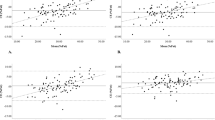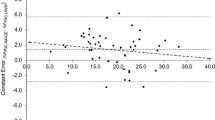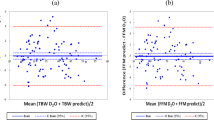Abstract
Background/objectives
The purpose was to determine if skinfolds (SF) and bioelectrical impedance analysis (BIA) could provide accurate estimates of body volume (BV) and total body water (TBW), respectively, for use in a 3-compartment (3-C) model to estimate percent body fat (BF%) when compared to laboratory derived measures.
Subjects/methods
A sample of sixty-four men (age = 22.9 ± 5.4 years) and 59 women (age = 21.6 ± 4.3 years) participated in the study. Laboratory 3-C (3CLAB) model BF% was determined with underwater weighing for body volume (BV) and bioimpedance spectroscopy for total body water (TBW). The 3-C field (3CFIELD) estimates of BF% included BV from the 7-site SF technique and TBW from hand-to-foot BIA.
Results
A significant difference in BF% (p < 0.01) was found between the 3CLAB and 3CFIELD in the entire sample and within the men, but the effect sizes (ES) were small (0.09 and 0.17, respectively). The difference between means was not significant in the women (ES = 0.05, p = 0.332). Compared to the 3CLAB, the total error (TE) ranged 2.2–2.4% for 3CFIELD, 5.7–5.8% for SF, and 4.0–4.6% for BIA.
Conclusions
The findings suggest that BV and TBW derived from SF and BIA, respectively, can be used in a 3CFIELD model to increase the accuracy of BF% estimates over SF and BIA alone.
This is a preview of subscription content, access via your institution
Access options
Subscribe to this journal
Receive 12 print issues and online access
$259.00 per year
only $21.58 per issue
Buy this article
- Purchase on Springer Link
- Instant access to full article PDF
Prices may be subject to local taxes which are calculated during checkout

Similar content being viewed by others
References
Pi-Sunyer FX, Xavier DM, Becker C, Bouchard RA, Carleton GA, Colditz WH, et al. Clinical guidelines on the identification, evaluation, and treatment of overweight and obesity in adults. Am J Clin Nutr. 1998;68:889–917.
World Health Organization. Preventing and managing the global epidemic. Report of a WHO consultation on obesity. World Health Organ Tech Rep Ser. 1998;2:894.
Moon JR. Body composition in athletes and sports nutrition: an examination of the bioimpedance analysis technique. Eur J Clin Nutr. 2013;67:S54–9.
Segal KR. Use of bioelectrical impedance analysis measurements as an evaluation for participating in sports. Am J Clin Nutr. 1996;64:469S–471S.
Piucco T, Santos SG. Association between body fat, vertical jump performance and impact in the inferior limbs in volleyball athletes. Fit Perform. 2009;8:9–15.
Cahill S, Jones M, Measurement of body composition and athletic performance during NCAA division I women’s volleyball and softball seasons.J Strength Cond Res. 2010;24:1
Chu SM, Gustafson KE, Leiszler M, Female athlete triad. Am J Lifestyle Med. 2013;7:387–394.
Siri WE, Body composition from fluid spaces and density: analysis of methods. Tech Meas body Compos.1961;61:223–44.
Brozek J, Grande F, Anderson JT, Keys A. Densitometric analysis of body composition: revision of some quantitative assumptions. Ann N Y Acad Sci. 1963;110:113–40.
Siri WE. Body composition from fluid spaces and density: analysis of methods. 1961. Nutr. 1993;9:480–91.
Withers RT, Laforgia J, Heymsfield SB. Critical appraisal of the estimation of body composition via two-, three-, and four-compartment models. Am J Hum Biol. 1999;11:175–85.
Wang J, Pierson RN. Disparate hydration of adipose and lean tissue require a new model for body water distribution in man. J Nutr. 1976;106:1687–93.
Moon JR, Tobkin SE, Smith AE, Roberts MD, Ryan ED, Dalbo VJ, et al. Percent body fat estimations in college men using field and laboratory methods: a three-compartment model approach. Dyn Med. 2008;7:7.
Moon JR, Hull HR, Tobkin SE, Teramoto M, Karabulut M, Roberts MD, et al. Percent body fat estimations in college women using field and laboratory methods: a three-compartment model approach. J Int Soc Sports Nutr. 2007;4:16.
Forslund AH, Johansson AG, Sjödin A, Bryding G, Ljunghall S, Hambraeus L. Evaluation of modified multicompartment models to calculate body composition in healthy males. Am J Clin Nutr. 1996;63:856–62.
Kavouras SA. Assessing hydration status. Curr Opin Clin Nutr Metab Care. 2002;5:519–24.
Jackson AS, Pollock ML. Practical assessment of body-composition. Phys Sportsmed. 1985;13:76–90.
Chumlea WC, Guo SS, Kuczmarski RJ, Flegal KM, Johnson CL, Heymsfield SB, et al. Body composition estimates from NHANES III bioelectrical impedance data. Int J Obes Relat Metab Disord. 2002;26:1596–609.
Moon JR, Tobkin SE, Roberts MD, Dalbo VJ, Kerksick CM, Bemben MG, et al. Total body water estimations in healthy men and women using bioimpedance spectroscopy: a deuterium oxide comparison. Nutr Metab. 2008;5:7.
Kerr A, Slater G, Byrne N, Chaseling J. Validation of bioelectrical impedance spectroscopy to measure total body water in resistance-trained males. Int J Sport Nutr Exerc Metab. 2015;25: 494–503.
Matias CN, Santos DA, Gonçalves EM, Fields DA, Sardinha LB, Silva AM. Is bioelectrical impedance spectroscopy accurate in estimating total body water and its compartments in elite athletes? Ann Hum Biol. 2013;40:152–6.
Gonçalves EM, Matias CN, Santos DA, Sardinha LB, Silva AM. Assessment of total body water and its compartments in elite judo athletes: comparison of bioelectrical impedance spectroscopy with dilution techniques. J Sports Sci. 2015;33: 634–40.
Moon JR, Eckerson JM, Tobkin SE, Smith AE, Lockwood CM, Walter AA, et al. Estimating body fat in NCAA division I female athletes: a five-compartment model validation of laboratory methods. Eur J Appl Physiol. 2009;105:119–30.
Moon JR, Tobkin SE, Smith AE, Lockwood CM, Walter AA, Cramer JT, et al. Anthropometric estimations of percent body fat in NCAA division I female athletes: a 4-compartment model validation. J Strength Cond Res. 2009;23:1068–76.
Cohen J. Statistical power anlaysis for the behavior science. 2nd ed. Hillsdale NJ: Routledge; 1998.
Bland JM, Altman DG. Statistical methods for assessing agreement between two methods of clinical measurement. Lancet. 1986;1:307–10.
Wang ZM, Deurenberg P, Guo SS, Pietrobelli A, Wang J, Pierson RN, et al. Six-compartment body composition model: inter-method comparisons of total body fat measurement. Int J Obes Relat Metab Disord. 1998;22:329–37.
Wang ZM, Deurenberg P, Wang W, Pietrobelli A, Baumgartner RN, Heymsfield SB. Hydration of fat-free body mass: review and critique of a classic body-composition constant. Am J Clin Nutr. 1999;69:833–41.
Stout JR, Housh TJ, Eckerson JM, Johnson GO, Betts NM. Validity of methods for estimating percent body fat in young women. J Strength Cond Res. 1996;10:25–9.
Stout JR, Eckerson JM, Housh TJ, Johnson GO, Betts NM. Validity of percent body fat estimations in males. Med Sci Sports Exerc. 1994;26:632–6.
Jackson AS, Pollock ML. Generalized equations for predicting body density of men. Br J Nutr. 1978;40:497–504.
Jackson AS, Pollock ML, Ward A. Generalized equations for predicting body density of women. Med Sci Sports Exerc. 1980;12:175–81.
Esco MR, Snarr RL, Leatherwood MD, Chamberlain NA, Redding ML, Flatt AA, et al. Comparison of total and segmental body composition using DXA and multifrequency bioimpedance in collegiate female athletes. J Strength Cond Res. 2015;29:918–25.
Kremer MM, Latin RW, Berg KE, Stanek K. Validity of bioelectrical impedance analysis to measure body fat in Air Force members. Mil Med. 1998;163:781–5.
Esco MR, Olson MS, Williford HN, Lizana SN, Russell AR. The accuracy of hand-to-hand bioelectrical impedance analysis in predicting body composition in college-age female athletes. J Strength Cond Res. 2011;25:1040–5.
Nickerson BS, Snarr RL, Russell AR, Bishop PA, Esco MR. Comparison of BIA and DXA for estimating body composition in collegiate female athletes. J Sport Hum Per. 2014;2:29–39.
Haas V, Schütz T, Engeli S, Schröder C, Westerterp K, Boschmann M. Comparing single-frequency bioelectrical impedance analysis against deuterium dilution to assess total body water. Eur J Clin Nutr. 2012;66:994–7.
Sun SS, Chumlea WC, Heymsfield SB, Lukaski HC, Schoeller D, Friedl K, et al. Development of bioelectrical impedance analysis prediction equations for body composition with the use of a multicomponent model for use in epidemiologic surveys. Am J Clin Nutr. 2003;77:331–40.
Withers RT, LaForgia J, Pillans RK, Shipp NJ, Chatterton BE, Schultz CG, et al. Comparisons of two-, three-, and four-compartment models of body composition analysis in men and women. J Appl Physiol. 1998;85:238–45.
Author information
Authors and Affiliations
Corresponding author
Ethics declarations
Conflict of interest
The authors declare that they have no conflict of interest.
Rights and permissions
About this article
Cite this article
Esco, M., Nickerson, B.S., Fedewa, M. et al. A novel method of utilizing skinfolds and bioimpedance for determining body fat percentage via a field-based three-compartment model. Eur J Clin Nutr 72, 1431–1438 (2018). https://doi.org/10.1038/s41430-017-0060-3
Received:
Revised:
Accepted:
Published:
Issue Date:
DOI: https://doi.org/10.1038/s41430-017-0060-3
This article is cited by
-
Longitudinal analyses of serum neurofilament light and associations with obesity indices and bioelectrical impedance parameters
Scientific Reports (2022)
-
Validity of a 3-compartment body composition model using body volume derived from a novel 2-dimensional image analysis program
European Journal of Clinical Nutrition (2022)



